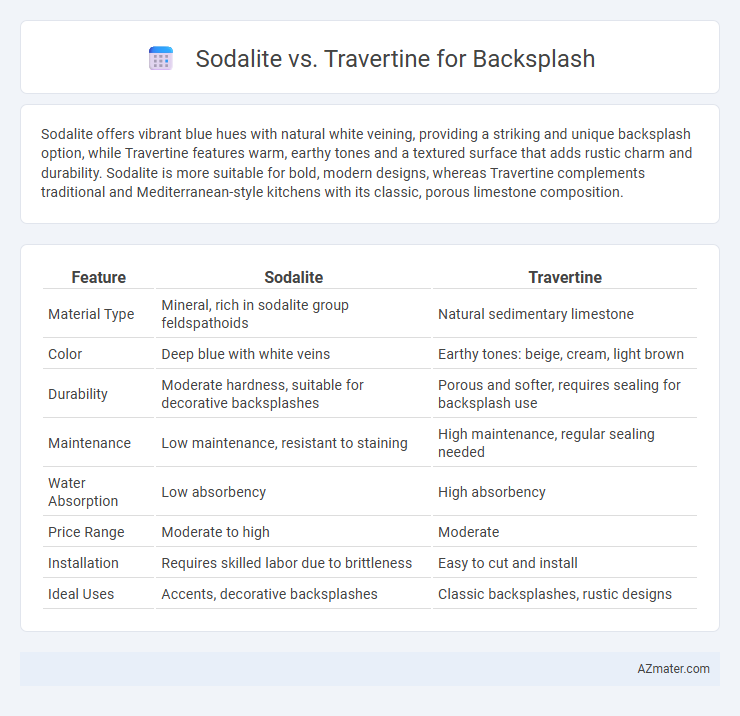Sodalite offers vibrant blue hues with natural white veining, providing a striking and unique backsplash option, while Travertine features warm, earthy tones and a textured surface that adds rustic charm and durability. Sodalite is more suitable for bold, modern designs, whereas Travertine complements traditional and Mediterranean-style kitchens with its classic, porous limestone composition.
Table of Comparison
| Feature | Sodalite | Travertine |
|---|---|---|
| Material Type | Mineral, rich in sodalite group feldspathoids | Natural sedimentary limestone |
| Color | Deep blue with white veins | Earthy tones: beige, cream, light brown |
| Durability | Moderate hardness, suitable for decorative backsplashes | Porous and softer, requires sealing for backsplash use |
| Maintenance | Low maintenance, resistant to staining | High maintenance, regular sealing needed |
| Water Absorption | Low absorbency | High absorbency |
| Price Range | Moderate to high | Moderate |
| Installation | Requires skilled labor due to brittleness | Easy to cut and install |
| Ideal Uses | Accents, decorative backsplashes | Classic backsplashes, rustic designs |
Introduction to Sodalite and Travertine Backsplashes
Sodalite backsplashes showcase a rich blue color with white veining, offering a bold and unique aesthetic ideal for contemporary kitchens. Travertine backsplashes feature a natural, earthy palette with beige and cream tones, bringing warmth and a classic Mediterranean touch to any space. Both materials provide durable, heat-resistant surfaces but vary significantly in texture and visual impact, making the choice dependent on design preference and kitchen style.
Visual Appeal: Color and Pattern Comparison
Sodalite showcases deep royal blues with white veining, creating a bold, striking visual contrast ideal for a dramatic backsplash. Travertine offers warm, earthy tones with natural pitting and linear patterns, adding a rustic, textured aesthetic perfect for traditional or Mediterranean-style kitchens. Choosing between the two depends on whether you prefer Sodalite's vibrant, high-contrast appearance or Travertine's subtle, organic elegance in kitchen design.
Durability and Longevity in Kitchen Environments
Sodalite offers moderate durability with good resistance to heat and moisture, but it is softer and more prone to scratching compared to travertine. Travertine is renowned for its long-lasting strength and can withstand kitchen wear, though it requires regular sealing to prevent staining and etching from acidic substances. Choosing travertine for a backsplash ensures greater longevity under heavy kitchen use, while sodalite may need more maintenance to retain its appearance over time.
Maintenance Requirements for Sodalite vs Travertine
Sodalite requires minimal maintenance due to its dense structure, needing only regular sealing and gentle cleaning with pH-neutral agents to preserve its vibrant blue hue. Travertine, being a porous natural stone, demands more frequent sealing and cautious cleaning to prevent staining and etching, especially in kitchen backsplash areas exposed to moisture and oils. Choosing sodalite for a backsplash offers easier upkeep and long-term durability compared to the higher maintenance demands of travertine.
Cost Differences and Budget Considerations
Sodalite offers a unique blue hue with moderate durability, usually priced between $10 to $30 per square foot, making it a budget-friendly option for backsplashes. Travertine, a natural limestone with warm, earthy tones, typically costs more, ranging from $15 to $50 per square foot due to its premium material and installation needs. Budget considerations should factor in both material prices and long-term maintenance, as travertine may require more upkeep, affecting overall cost efficiency for backsplash projects.
Installation Process: Ease and Challenges
Sodalite backsplashes require precise cutting and sealing due to their natural stone composition, demanding professional installation to ensure durability and aesthetic appeal. Travertine, characterized by its porous surface, often necessitates thorough sealing and careful grout application to prevent staining and moisture damage, making the installation slightly more labor-intensive. Both materials pose challenges but offer rewarding results when installed with appropriate tools and expertise tailored to their unique physical properties.
Water and Stain Resistance Properties
Sodalite offers superior water resistance compared to travertine, making it less prone to water absorption and damage in backsplash applications. Travertine is a porous natural stone that requires proper sealing to prevent stains and water penetration, which can lead to discoloration and surface etching over time. Choosing sodalite for backsplashes ensures enhanced durability against moisture and staining, reducing maintenance needs and preserving aesthetic appeal.
Eco-Friendliness and Sourcing Ethics
Sodalite, a rare mineral often sourced from limited locations, offers a unique blue hue but may involve higher environmental impact due to mining practices and transportation emissions. Travertine, a form of limestone commonly quarried in countries like Italy and Turkey, tends to have more established eco-friendly certifications and ethical sourcing guidelines, promoting responsible quarrying and reduced carbon footprint. Choosing travertine for a backsplash typically aligns better with sustainability goals given the industry's focus on minimizing waste and restoring mined areas.
Popular Design Styles Using Sodalite or Travertine
Sodalite backsplashes are favored in modern and eclectic design styles for their deep blue hues and striking white veining that create bold, artistic focal points. Travertine complements rustic, Mediterranean, and traditional kitchens with its warm, earthy tones and natural pitted textures that add timeless elegance and organic warmth. Both materials enhance various aesthetics, with Sodalite offering dramatic color contrasts and Travertine providing soft, natural stone appeal.
Which Material is Best for Your Backsplash?
Sodalite offers a striking deep blue color with unique veining, making it ideal for a bold, modern backsplash that resists heat and stains effectively. Travertine, characterized by its warm beige tones and natural pitted texture, provides a classic, rustic aesthetic but requires sealing to prevent water damage and staining in kitchen environments. For durability and ease of maintenance, sodalite outperforms travertine, making it the best choice for a long-lasting, low-maintenance backsplash.

Infographic: Sodalite vs Travertine for Backsplash
 azmater.com
azmater.com